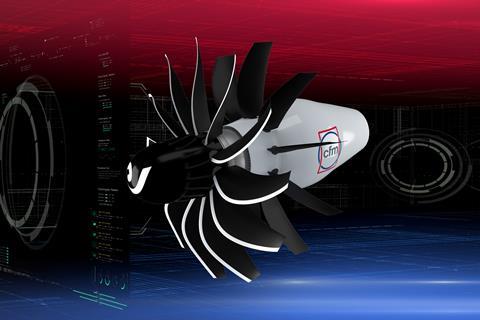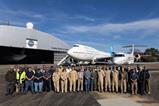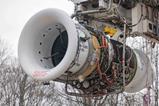During Farnborough International Airshow, CFM International, a 50-50 joint company between GE and Safran Aircraft Engines, and Airbus announced plans to flight test CFM’s cutting-edge open fan engine architecture. Hear from GE’s Chief Engineer Chris Lorence about why he thinks the time for open fan is now.
The a-ha moment came around 2014. At the time I was leading GE’s advanced technology team, a group of technical engineers whose sole role is to test the boundaries of what’s possible. We were probing the possibilities of improving fuel efficiency with the goal to see how far we could push.
GE had designed and tested open fan designs dating back to the 1980s and we had advanced significantly on that work, but a counter-rotating fan was essentially a given to us at that point. That’s when one of the engineers asked, “Why does it have to counter-rotate? What if it’s single stage?”

It was like a lightbulb went off. One of those moments when you’ve worked on something for so long that you can’t see it any other way, and then someone did. It wasn’t just a breakthrough, it was radical. A single stage fan that wasn’t simply a propeller, but rather one set of rotating fan blades with the same speed and performance of a counter-rotating fan.
As chief engineer of GE and a GE engineer for the last 27 years, I’ve watched how we’ve incrementally improved fuel efficiency with each successive new commercial aircraft engine design. The LEAP engine*, introduced in 2016, is 15 percent more efficient than CFM56-5B and -7B engines. The GEnx engine is up to 15 percent more efficient than the CF6-80C2, and the GE9X engine has been designed to be up to 10% more efficient than the GE90-115B.
But the push for 20 percent greater fuel efficiency in one generation? That is something different. Engineers like big challenges, and this is certainly one of them.
To address this challenge, CFM International, our 50-50 joint company with Safran, announced the CFM RISE* (Revolutionary Innovation for Sustainable Engines) technology demonstration program back in June 2021, targeting reduced fuel consumption and CO2 emissions by more than 20 percent compared to today’s most efficient engines.
Central to the program is state-of-the-art propulsive efficiency for the engine, including advancing the open fan architecture.
The path to 20% lower fuel consumption
In the past, when we’ve broached the open fan, it’s been in response to rising fuel prices. The technology foundation from our work in the 1970s with NASA’s Quiet Clean Short-Haul Experimental Engine (also known as QCSEE) and in the 1980s with the GE36 open fan is what we are building on today.
With the CFM RISE Program, our engineers are again pushing the limits to develop even more advanced technologies than we have before. What’s different this time is why. We are now at a point in the dialogue where fuel prices aren’t driving the discussion. Instead, we are putting all of our best technology on the table toward an even bigger, more impactful goal — reducing CO2 emissions to achieve a more sustainable aviation industry.
Last year, I joined other Chief Technology Officers prior to COP26, the United Nation’s climate conference, to issue a joint statement reaffirming our industry’s commitment to achieve industry-wide Air Transport Action Group (ATAG) targets, including the goal of net zero CO2 emissions by 2050. This supports the Paris Agreement goal to limit global warming to 1.5ºC compared to pre-industrial levels.
The CTO statement is four pages long but, in essence, it reflects our promise to relentlessly pursue efficiency. And, quite simply, the open fan architecture is an essential component in GE’s plan to lead in the march toward net zero.
Why open fan?
Over the last 50 years, we’ve learned how to make the open fan engine design simpler and lighter. Stationary outlet guide vanes replace previous two-stage, counter-rotating fan blades in our latest designs. This change is significant because we can direct air flow and fly at speeds consistent with conventional turbofan engine architectures.
More recently, we’ve made significant improvements in acoustics, which had been an inhibiting factor. Open fan acoustics are where we need them to be for commercial service and we are actually on the lower end for noise certification.
Add to that our fourth generation - and the industry’s only - carbon fiber composite fan blades, which are well suited to move to an open fan engine. No one else in the industry has the depth of expertise or composite fan experience that GE has.
The challenge when you work in advanced technology is coming up with something that is revolutionary, rather than evolutionary. To achieve the bold goals that we and the industry are driving toward, revolutionary design is the only solution. And like my colleague pointed out in 2014, when you go from counter-rotating to single-stage, your mind expands. You think, ‘Wow, this is truly revolutionary.’
While ducts (or fan cases/nacelles) perform some aerodynamic function, their primary function is structural. But they weigh a ton. Literally. And when you take most of that weight away with the open fan design, you also remove propulsion drag.
We joke that removing the nacelle lets a fan blade be a fan blade. When there is a nacelle, you have to decide how big you want the fan to be. But when you remove the nacelle, the fan is able to be as big as it needs to be from an aerodynamic standpoint. Even with larger blades, the open fan is not much bigger than the nacelle we have around the CFM LEAP engine today. In fact, the blades for the RISE Program’s open fan are not much bigger than the GE9X fan blades.

The time is now
As the GE team rises to the aviation industry’s challenge to achieve net zero CO2 emissions by 2050, open fan architecture also awakens our collective excitement because it’s an obvious change from the traditional turbofan aircraft engine. This is the most exciting—and the most challenging—time to be an engineer. I tell people just starting their careers in our Edison Engineering Development Program that if they aren’t excited about this program, then they are probably in the wrong place. It takes everything we thought we could do with jet engines previously and says, ‘Nah, we can do better.’
And the time is now. While global aviation produced just 2 percent of human-induced carbon dioxide (CO2) emissions in 2019, passenger air traffic is expected to grow in coming years, and it is incumbent upon us to act quickly.
Safety is our top priority. As chief engineer for GE, I am primarily responsible for product safety. My team and I will ensure that safety supersedes all else during our ground and flight tests for the open fan, and as always, we will work closely with our regulators before it enters into service.
Air transport plays a key role in reaching climate targets. Open fan architecture is the radical change aviation needs to achieve its goals; we cannot reach them without it.
Hot off the Press: July 19, 2022 it was announced at the Farnborough Air Show, that the Airbus A380 would test open-fan architecture in flight

*RISE, CFM56, and LEAP are all registered trademarks and programs of CFM International, a 50-50 joint company between GE and Safran Aircraft Engines.





























